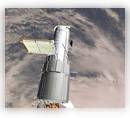 (Shuttle Mission: STS-109) (Shuttle Mission: STS-109)
Shuttle: Columbia
Date: March 1 - 12 2002
Servicing Mission 3B was actually the fourth visit to Hubble. NASA
split the original Servicing Mission 3 into two parts and conducted
3A in December of 1999. During SM3B a new science instrument will be installed: the Advanced
Camera for Surveys (ACS). Several other activities were
accomplished as well over a 12-day mission with 5 spacewalks.

ACS Installation:
With its wide field of view, superb image quality, and exquisite sensitivity,
Hubble's newest science instrument, the Advanced
Camera for Surveys (ACS) will have 10 times more discovery power than the camera it replaces. In other words, ACS can produce 10 times as
many science results in the same amount of time.
(click for larger
picture)
ASC sees in wavelengths ranging from visible to far ultraviolet.
It is actually a team of three different cameras with specialized capabilities.
The high resolution camera will take extremely detailed pictures of the
inner regions of galaxies and search neighboring stars for planets and planets-to-be.
The solar blind camera blocks visible light to enhance ultraviolet sensitivity.
Among other things, it will be used to study weather on planets in our own
solar system. With a field of view twice the size of Hubble's current surveyor,
ACS's wide field camera will conduct new surveys of the universe. Astronomers
will use it to study the nature and distribution of galaxies in order to understand how our universe evolved. (click for diagram of parts)
Solar Array 3 (SA3) Installation:
Four large flexible solar array (SA) panels (wings) provide power
to the observatory.
During SM1, the original arrays were
replaced by SA2 and have powered Hubble for over 8 years. Radiation
and debris take their toll on sensitive electronics, which will
be replaced to ensure uninterrupted service for the remainder of the
mission.
The new solar arrays (SA3) are rigid arrays, which do not roll up
and therefore are more robust. Hubble gets a brand new look with
its latest set of solar wings. Although one-third smaller than the
first two pairs, the power increase was between 20 and 30 percent. They
are less susceptible to extreme temperatures and their smaller-sized
will reduce the effects of atmospheric drag on the spacecraft. (see
dimensions of solar panel array) |
 |
 |
Power Control Unit (PCU):
As Hubble's power switching station, the PCU controls and distributes electricity
from the solar arrays and batteries to other parts of the telescope. Replacing
the original PCU, which had been on the job for 11 years, required Hubble
to be completely powered down for the first time since its launch in 1990.
Hubble's new PCU will allow astronomers to take full advantage of extra
power generated by the new solar arrays.
NICMOS Cryocooler (NCC) Installation:
Astronauts retrofitted an existing but dormant instrument called the Near
Infrared Camera and Multi-Object Spectrometer (NICMOS) with a new, experimental cooling system to return it to active duty. NICMOS
was placed on Hubble in 1997 but became inactive two years later, after
depleting the ice it needed to cool its infrared detectors. By fitting NICMOS
with the experimental cryogenic system, NASA hopes to re-cool the detectors
to -334°F (-203°C or 70 K) revive its infrared vision, and extend
its life by several years.
The super-quiet cooler uses ultra-high speed microturbines, the fastest
of which spins at over 200,000 rpm (over 50 times the maximum speed of a
typical car engine). Hubble's engineering team successfully demonstrated
this technology in 1998 aboard STS-95 in the first on-orbit test of a high-performance,
high-efficiency, mechanical cryocooler.
CLICK HERE for a special
look at the making of NCS.

STS-109 Crew Info: NASA Astronaut Bios
Four astronauts trained for five scheduled spacewalks to upgrade
and service the Hubble Space Telescope during the STS-109 mission in early
2002. Three veteran astronauts, John
M.Grunsfeld, James
H. Newman, and Richard
M. Linnehan, were joined by Michael J. Massimino, who will be making his first space flight.
Grunsfeld had flown three times, STS-67 in 1995, STS-81 in 1997, and STS-103
in 1999 when he performed two spacewalks to service the Hubble Space Telescope.
Newman, veteran of three space flights, STS-51 in 1993, STS-69 in 1995,
and STS-88 in 1998, had conducted four previous spacewalks. Linnehan had
flown on STS-78 in 1996 and STS-90 in 1998. Massimino is a member of the
1996 astronaut class.
Scott
Altman, (Cmdr., USN), a two-time shuttle veteran, commanded the STS-109
mission. He was joined on the flight deck by pilot Duane
Carey, (Lt. Col., USAF), making his first space flight, and flight engineer Nancy
Currie (Lt. Col, USA, Ph.D.). Currie had three previous space flights
to her credit. |